Hurricanes Turn Up the Heat
- By AMS Staff
- May 3, 2023
5.2°C—The maximum increase in apparent temperature above average observed following a tropical cyclone in a new study published in the Journal of Geophysical Research. Scientists used a Lagrangian analysis framework to study 53 tropical cyclones in the eastern Caribbean for the years 1991–2020 as well as 205 occurrences of those storms impacting Caribbean cities. They found that in every case, the cities’ heat index values were warmer than average after the storm, with maximum heat index anomalies sometimes occurring several days after the storm's passage and/or in locations not directly impacted by the storm. “Hurricanes are massive heat pumps, redistributing heat for a large spatial distance around the center of the storm,” explains lead author Zackry Guido of the University of Arizona. The findings highlight an often-overlooked aspect of storm preparedness, and Guido points out that the destruction caused by a tropical storm, including ruined energy grids, combined with the high heat that follows can impede recovery and pose a danger to human health. “We want to call attention to this as a new hazard,” Guido says.
University of Arizona, Image: Hurricane Fiona over the Dominican Republic and Puerto Rico in September 2022, captured by NOAA's GOES-East satellite. Photo Credit to CIRA/NOAA
